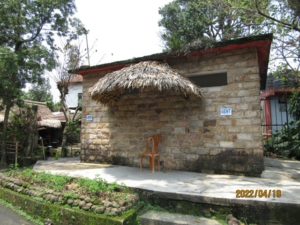By Priyan R Naik
 When I visited Shillong, Sohra, Mawlynnong, Dawki and other places in Meghalaya, I was fixated on how clean and tidy it was everywhere. It appeared as though everybody in Meghalaya had a fetish for cleanliness. Irrespective of the age group or the gender, from young school children to old toothless grannies, everyone seemed to have a stake in ensuring
When I visited Shillong, Sohra, Mawlynnong, Dawki and other places in Meghalaya, I was fixated on how clean and tidy it was everywhere. It appeared as though everybody in Meghalaya had a fetish for cleanliness. Irrespective of the age group or the gender, from young school children to old toothless grannies, everyone seemed to have a stake in ensuring  their surroundings and living spaces were spick and span
their surroundings and living spaces were spick and span
Nowhere was this more visible than in the village of Mawlynnong, chosen in 2003 by Discover India  magazine as Asia’s cleanest village. Everybody in this village seemed keen to ensure discarded bottles, crumpled food wrappers, plastic bags, cigarette butts and trash were carefully put away. Dustbins made out of beautiful hand-woven wicker
magazine as Asia’s cleanest village. Everybody in this village seemed keen to ensure discarded bottles, crumpled food wrappers, plastic bags, cigarette butts and trash were carefully put away. Dustbins made out of beautiful hand-woven wicker  baskets in the shape of an inverted cone were found at intervals of 30 meters. A detail that cannot be overlooked was that the baskets themselves were visually so appealing that one would hesitate to discard rubbish into them.
baskets in the shape of an inverted cone were found at intervals of 30 meters. A detail that cannot be overlooked was that the baskets themselves were visually so appealing that one would hesitate to discard rubbish into them.
 Huge notice boards were hung by the village headman prescribing what kind of garbage could be disposed off into the inverted cone baskets – one item on the board read “Only such wastes as fruits/banana peels, snack wrappers and small wrappers of sweets, chocolates and chewing gum are allowed to be thrown in the dustbins/baskets”.
Huge notice boards were hung by the village headman prescribing what kind of garbage could be disposed off into the inverted cone baskets – one item on the board read “Only such wastes as fruits/banana peels, snack wrappers and small wrappers of sweets, chocolates and chewing gum are allowed to be thrown in the dustbins/baskets”.  In case instructions were not followed, the offender was liable to be fined or could be handed over to the police. Significantly, people not just cleaned their own houses, but stepped out to sweep public roads that were adjacent to their houses. Cleanliness seemed to be ingrained into their psyche. As I walked on the street, I could see almost
In case instructions were not followed, the offender was liable to be fined or could be handed over to the police. Significantly, people not just cleaned their own houses, but stepped out to sweep public roads that were adjacent to their houses. Cleanliness seemed to be ingrained into their psyche. As I walked on the street, I could see almost  every compound had a clothesline on which hung piles of clothes drying in the sunshine. The cleanliness did not seem ‘put-on’ or superficial but was deep-rooted and permeated into their personal lives! It seemed like a long-time tradition! The possible reason for this is because Mawlynnong is mainly inhabited by the
every compound had a clothesline on which hung piles of clothes drying in the sunshine. The cleanliness did not seem ‘put-on’ or superficial but was deep-rooted and permeated into their personal lives! It seemed like a long-time tradition! The possible reason for this is because Mawlynnong is mainly inhabited by the  traditionally matrilineal Khasi tribe. With women having a dominant role in society, it is but natural that they ensure their homes and surroundings are kept neat and orderly.
traditionally matrilineal Khasi tribe. With women having a dominant role in society, it is but natural that they ensure their homes and surroundings are kept neat and orderly.
Why only Mawlynnong? On my way to see a living root bridge, I had to pass through Riwai village. The same story was repeated here as well, the village looked spotless. The villagers had to put up with hordes of tourists criss-crossing their pathways on the way to the root bridge, only to demonstrate the same phobia for cleanliness! Quaint looking ‘restrooms’ are provided for the tourists. Made from local material, they had a thatched overhang for adequate shade for the ‘cleaner’. Cleanliness seemed to be a way of life in the quaint and vibrant little villages of Meghalaya!
Ditto for the urban conglomeration of Shillong, one can see waste duly segregated in three separate streams, biodegradable, non-biodegradable and domestic all kept suitably in separate bins waiting to be collected by waste pickers. Within the city, one needs only visit Ward’s Lake to appreciate its clean and pristine precincts. Here one witnesses the janitorial staff busy at work. Notwithstanding a multitude of tourists pottering all over, sweepers with brooms in their hands worked away without looking hither or thither singularly focused on keeping their area orderly!
Looking at the janitorial staff in Shillong, I was reminded of the sweepers in Bengaluru. Called ‘Pourakarmikas’ (garbage cleaners), they are a familiar sight on city roads, discernible with their garden green and tangerine uniforms. Brooms in hand, they are usually shouting and yelling at each other, stressed as they are with the responsibility of keeping a huge city clean, in total contrast to the devoted and hardworking cleaners in Shillong who seem to quietly work without making a fuss!
*************
Priyan R Naik is a Bengaluru based contributor at The Shillong Times .



